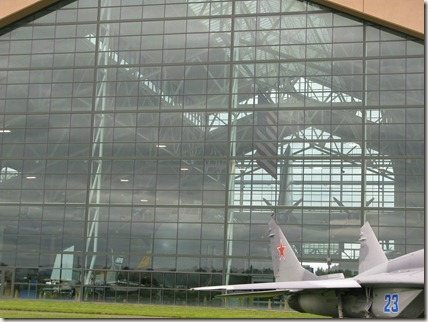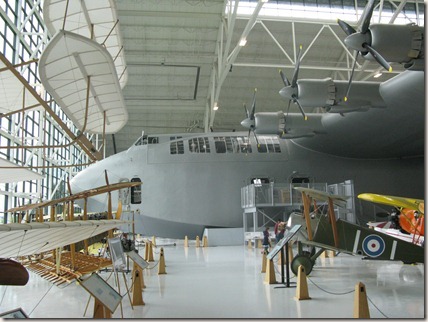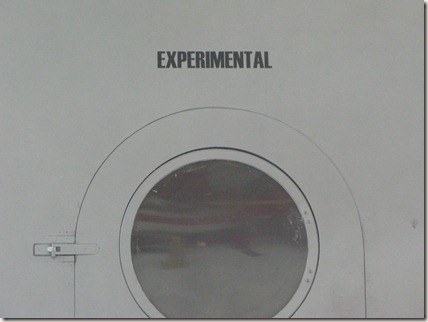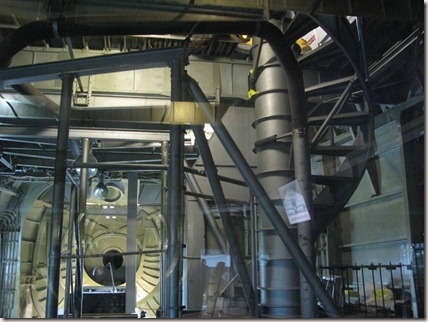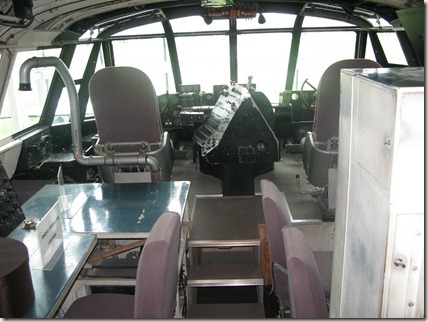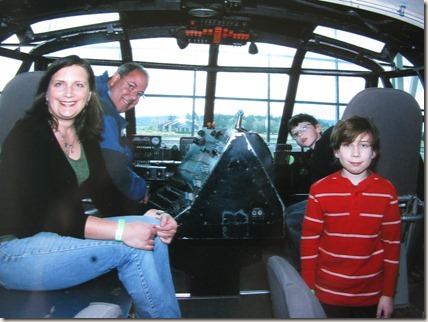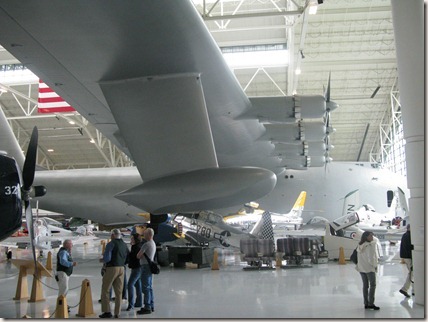Visiting the Spruce Goose for my birthday
For my birthday last weekend, we drove to Portland, Oregon. I've always wanted to see Howard Hughes' Hercules H-4, also known, derisively, as the Spruce Goose. The H-4 is in McMinnville, Oregon, at the Evergreen Air and Space Museum, about an hour outside of Portland.
On Saturday afternoon, we drove to McMinnville under a leaden sky. Traffic was heavy as we drove through small towns on 99 West. We took the long way (thanks to GPS), but pulling up to the Evergreen Museum and seeing the Spruce Goose staring down through the glass made my jaw drop. Nothing can prepare you for the size of this aircraft.
If for some reason you can't make out the plane behind the glass, here's the approximate outline:
Inside, the plane overwhelms much of the museum, as you can see here:
H-4 Hercules - A History
Howard Hughes developed his flying boat during World War II in partnership with Henry J. Kaiser, who was the builder of "Liberty Ships." The idea for a flying boat was a response to the devastating ship losses from U-boat attacks. Hughes and Kaiser received an $18 military contract to build three flying boats. The first would be the HK-1 (for Hughes-Kaiser 1).
Building an aircraft like the Hercules would be difficult under the best of conditions, but the engineers faced numerous design challenges. The first was that they couldn't use any material deemed critical to the war effort. Instead of using metals, such as aluminum, they had to build the aircraft entirely out of wood. They solved this problem by using a "Duramold" process, which had been used on smaller aircraft but never on something so large.
Next, they had to create a new system for the control surfaces like the rudder and the ailerons. The aircraft was so large that no one pilot had the strength to move the surfaces with traditional controls. This called for a new "power boost" system that amplified a pilot's movements (still in use today in modern aircraft).
All of this research and development took time, and eventually Kaiser lost interest and pulled out of the project. Hughes continued to develop it himself, which he renamed the H-4.
The H-4 was built on a scale never seen before, with a wingspan larger than a football field, and standing over five stories tall. Eight radial engines powered the beast. It was designed to shuttle 750 troops or two tanks. But the war would end before the H-4 was completed. Hughes didn't care; he kept on building it with $7 million of his own money.
In 1947, Hughes was called before the Senate War Investigating Committee, which was investigating Hughes for war profiteering and corruption. But the investigation, led by Senator R. Owen Brewster, got more than they bargained for with the tenacious Hughes. Hughes testified that the hearings were set up to destroy his reputation so Brewster's friend Juan Trippe -- and CEO of Pan Am -- could buy Hughes' TWA, which was trying to compete with Pan Am.
During the testimony, Hughes threw down the gauntlet, "The Hercules was a monumental undertaking. It is the largest aircraft ever built. It is over five stories tall with a wingspan longer than a football field. That's more than a city block. Now, I put the sweat of my life into this thing. I have my reputation all rolled up in it and I have stated several times that if it's a failure I'll probably leave this country and never come back. And I mean it."
During a break from the hearings, Hughes left for California to take out the H-4 for testing near Long Beach. He wasn't supposed to take off, but that's exactly what he did -- flying for a little over a mile. It was the first and last time the H-4 would fly. Hughes' reputation was intact. For years, Hughes kept a crew who maintained the H-4 and kept it ready to fly.
After Hughes' death in 1976, the H-4 was acquired by several companies, including Walt Disney. But in 1993, the H-4 arrived at its new home in McMinnville, Oregon, after a 138-day journey from Long Beach.
Meeting the Hercules
My first impression of seeing the silver Hercules inside the museum, besides being overwhelmed by its size, was its craftsmanship. I used to row at the University of Washington, and I remember having the same response when seeing the wooden shells stacked up inside the boathouse. Like those Pocock wooden shells (we'd get the faster, lighter carbon fiber boats when we were sophomores), the Hercules was also made of wood.
We know now that Hughes was an extreme perfectionist, and you get the feeling that the Hercules was more than an airplane to him. It was his masterpiece. No wonder it was so important for him finish it (with his own money) and finally see it fly.
Another thing I noticed on the outside of the Hercules was the size of the eight engines. These seemed smaller than I thought they'd be, which is probably one of the reasons they needed eight of them. (Each engine produced 3,000 horsepower). I read that after flying the Hercules, Hughes realized it was woefully underpowered.
As I walked up the stairs to step inside the plane, I noticed that the doors looked like ones you'd see on ships instead of airplanes. "EXPERIMENTAL" was painted above every door.
Inside the belly of the plane, you could see the spiral stair going up to the flight deck:
And the only way you could go up to the flight deck is by paying $25 for a photo (up to six people per photo, I believe). So we paid and walked onto the flight deck. It looked just like what I remember in The Aviator film (although they didn't use the real Hercules in the film), but the flight deck wasn't set as high.
Finally, I squeezed into the pilot's seat, and the rest of my family sat around me. I can't imagine what it must have been like to fly this monster. Hercules is an apt name.
After getting our picture, we walked around the museum (which also includes a "Space" wing in a separate building). As we left at the end of the day, my thoughts kept returning to the man who built Hercules. It's people like Howard Hughes who move innovation forward. And the madness that he suffered, in the form of obsessive compulsive disorder, was one of the demons that drove him to create, finish, and fly this plane. It makes you wonder: what would have happened if he'd been cured of his illness. Would the Hercules exist? What else would he have done?
We'll never know.
